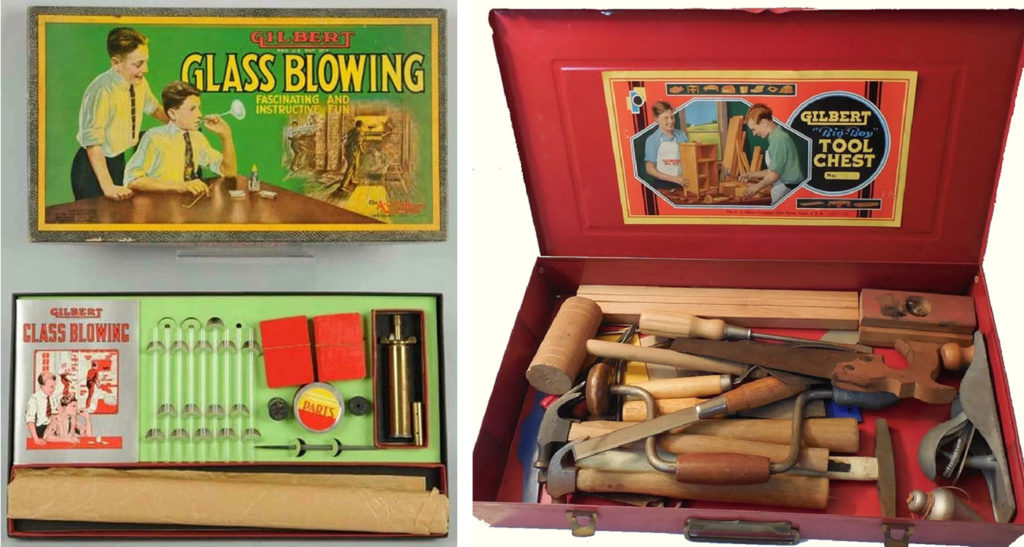THE MAN WHO SAVED CHRISTMAS
 Gilbert, as a boy, took an interest in magic. Gilbert’s magic act became his vehicle for paying his college expenses. In 1909 he started selling illusionist kits that included detailed instructions on how to use the materials in his kits for magic performances. In 1910, puzzles were introduced by Gilbert’s company, the Mysto Manufacturing Company. Complete tool sets were soon added to the toy line including benches, wood lathes, and scroll saws along with detailed instructions for construction.
Gilbert, as a boy, took an interest in magic. Gilbert’s magic act became his vehicle for paying his college expenses. In 1909 he started selling illusionist kits that included detailed instructions on how to use the materials in his kits for magic performances. In 1910, puzzles were introduced by Gilbert’s company, the Mysto Manufacturing Company. Complete tool sets were soon added to the toy line including benches, wood lathes, and scroll saws along with detailed instructions for construction.
Answer
In 1898, in England, Frank Hornby introduced the Meccano Kit, which was a simple construction toy involving various quantities of different lengths of identical ½” wide metal strips, each strip with a series of evenly spaced holes down its central axis. The kits also contained ½” x ½” angles of different lengths along with square and triangular plates also drilled with evenly spaced holes. The kits allowed children to construct whatever they could dream up.
 Having seen Frank Hornby’s construction toy set, Gilbert knew he could improve upon Hornby’s design and features. In 1911 Gilbert offered the Mysto Erector Structural Steel Builder manufactured by the Mysto Manufacturing Company, which also offered his magic kits. By 1913 he had made further improvements by making the steel strips look like actual riveted beams of the era and was selling the improved version using just the Erector name. In 1916, with sales exploding, the company expanded and reorganized under the A.C. Gilbert Company name. By 1930 Gilbert had bought out his competitor, Meccano.
Having seen Frank Hornby’s construction toy set, Gilbert knew he could improve upon Hornby’s design and features. In 1911 Gilbert offered the Mysto Erector Structural Steel Builder manufactured by the Mysto Manufacturing Company, which also offered his magic kits. By 1913 he had made further improvements by making the steel strips look like actual riveted beams of the era and was selling the improved version using just the Erector name. In 1916, with sales exploding, the company expanded and reorganized under the A.C. Gilbert Company name. By 1930 Gilbert had bought out his competitor, Meccano.
With the company’s name change, Gilbert also formed the Toy Manufacturers of America in 1916, which would prove vital to insuring children had toys for Christmas 1918. While World War I started in 1914, America’s participation was as a bystander. President Woodrow Wilson established the Council of National Defense in 1916 for the purpose of coordinating resources and industry support should America find itself drawn into World War I. The council’s charter was to coordinate America’s resources related to transportation, industrial production, farm production, financial resources, and American labor. The council’s objective was to support America’s position that “a country is best prepared for war when thoroughly prepared for peace.” In April 1917, the United States declared war on Germany and entered World War I with the defense council fully engaged.
By mid-1918 the Council of National Defense had focused America’s industrial and labor might towards manufacturing war related items. The Council banned the manufacture of many items considered nonessential. By the end of 1918 toy manufacturers had become concerned that while a few toy plants had been converted to producing war related items, the rest would be closed down as non-essential so that labor, energy, and raw materials could be redistributed. The result would be the toy manufacturer’s biggest income period of the year, Christmas, would disappear and resulting in many of the companies going out of business.
As president of the Toy Manufacturers of America, Gilbert arranged a meeting with the leaders of the Council of National Defense. During that short meeting, in addition to displaying a large selection of A.C. Gilbert Company toys, books, and other educational and learning toy materials, Gilbert stated:
“The greatest influence in the life of a boy is his toys.
A boy wants fun, not education. Yet through the kind of toys American toy manufacturers are turning out, he gets both. The American boy is a genuine boy, and he wants genuine toys. He wants guns that really shoot, and that is why we have given him air rifles from the time he was big enough to hold them. It is because of toys they had in childhood that the American soldiers are the best marksmen on the battlefields of France.
America is the home of toys that educate as well as amuse, that visualize to the boy his future occupations, that start him on the road to construction and not destruction, that as fully as public schools or Boy Scout system, exert the sort of influences that go to form right ideals and solid American character.”
Gilbert’s argument won the defense council over, and the discussions of closing America’s toy manufacturers as being non-essential was abandoned. The Boston Globe’s headline summarizing the meeting’s outcome was “The Man Who Saved Christmas.”

